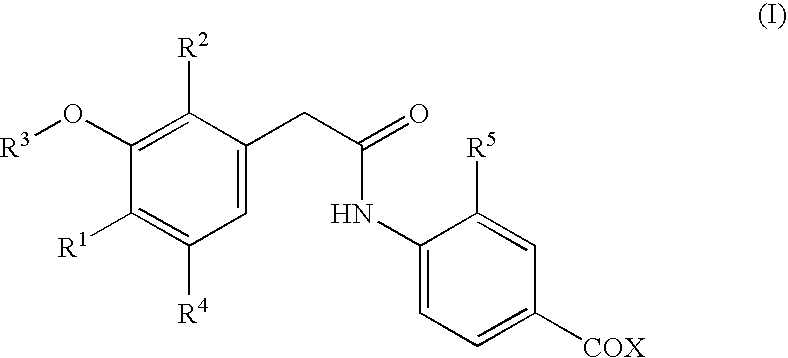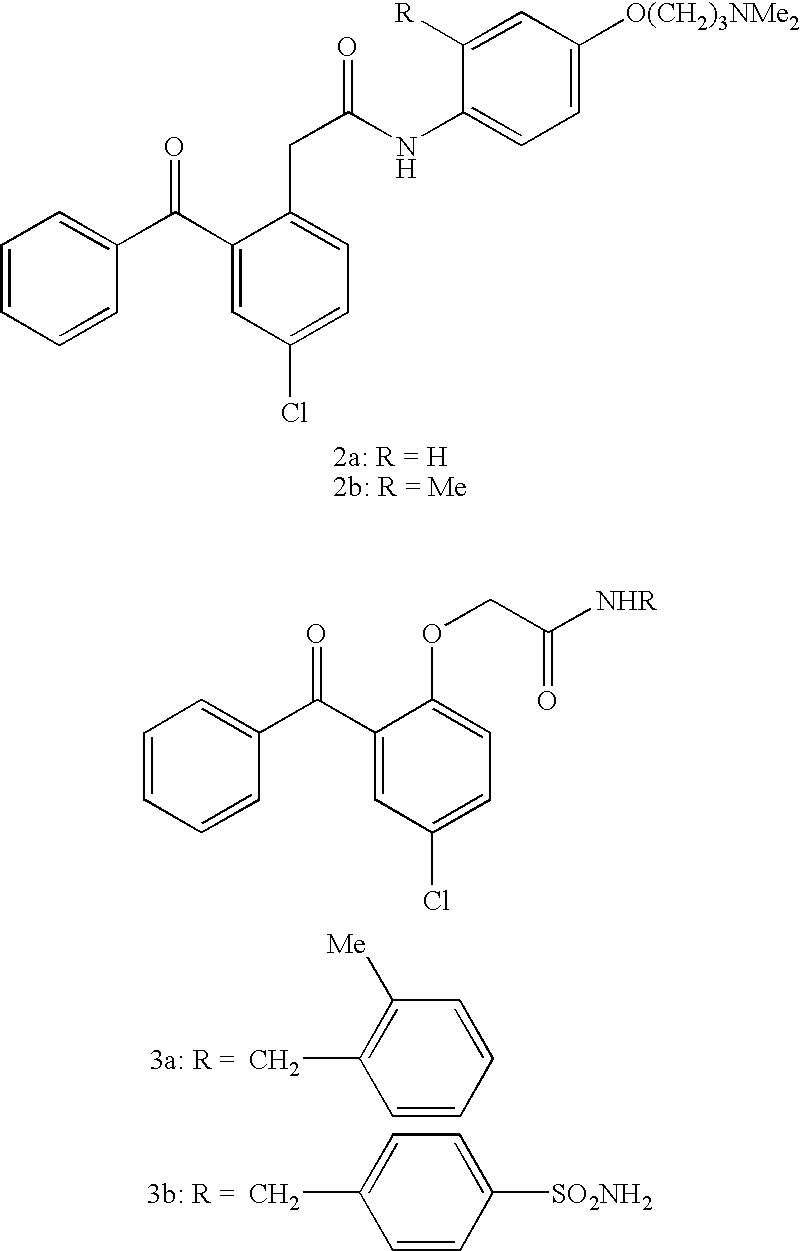Non-nucleoside reverse transcriptase inhibitors
a reverse transcriptase inhibitor and non-nucleoside technology, applied in the field of antiviral therapy, can solve the problems of slowed disease progression, significant therapeutic problems, and high viral load, and achieve the effect of reducing susceptibility to therapy
- Summary
- Abstract
- Description
- Claims
- Application Information
AI Technical Summary
Benefits of technology
Problems solved by technology
Method used
Image
Examples
example 1
4-{2-[4-Bromo-3-(3-chloro-5-cyano-phenoxy)-2-fluoro-phenyl]-acetylamino}-3-chloro-N-(2-pyrrolidin-1-yl-ethyl)-benzamide (I-32)
[0150]
[0151] The phenyl acetic acid 30a was prepared as described in example 3.
[0152] step 1—A 150 mL three-neck round bottom flask was charged with MeCN (50 mL), CuBr (2.8 g, 12.61 mmol) and 1-butyl nitrite (1.4 g, 13.76 mmol), degassed and maintained under an Ar atmosphere and heated to 70° C. To the mixture was added dropwise a solution of 30a (4.0 g, 11.47 mmol) dissolved MeCN (20 mL). The reaction mixture was stirred at 70° C for 4 h and then cooled to 0° C. The reaction was quenched by addition of 10 % HCl (30 mL) and extracted with EtOAc. The combined extracts were sequentially washed with 10% HCl and brine. The organic extract was dried (Na2SO4), filtered and the volatile solvents removed in vacuo to yield a black oil which was purified by flash chromatography on silica gel (hexanes:EtOAc 95:5) to afford 2.5 g (52.8% theory) of 30c.
[0153] Step 2 wa...
example 2
4-{2-[4-Bromo-3-(3-chloro-5-cyano-phenoxy)-2-fluoro-phenyl]-acetylamino}-3-methyl-N-(2-pyrrolidin-1-yl-ethyl)-benzamide (I-27)
[0161]
[0162] 4-Amino-3-methyl-benzoic acid, tert-butyl ester—Benzene sulfonyl chloride (12.8 mL, 1 equiv) was added to a solution 38a (18.1 g, 99 mmol) in pyridine (200 mL). The solution was stirred for 15 min, and tert-butyl alcohol (9.4 mL, 1 equiv) was added dropwise. After 1.5 h, the solution was poured into 400 mL of ice-water and stirred for 1 h. The solution was filtered, and the solvent was collected and dried under vacuum. This material was dissolved in toluene and passed through a plug of silica to provide, after evaporation of the volatile materials, 6.6 g (28%) of 38b.
[0163] A suspension of 38b (6.6 g, 27 mmol) and 10% Pd / C (0.55 g) in EtOH (200 mL) was agitated under H2 (60 psi) for 3 h. The solution was filtered through CELITE®, and the volatile materials were evaporated to afford 5.7 g (99%) of 39 as an oil that slowly solidified.
[0164] step...
example 3
3-Chloro-4-{2-[4-chloro-3-(3-chloro-5-cyano-phenoxy)-2-fluoro-phenyl]-acetylamino}-N-(2-dimethylamino-ethyl)-benzamide (I-21)
[0183]
Steps 1 and 2 are depicted in Scheme 3
[0184] step 1—A 100 ml round bottom flask was charged under a stream of nitrogen with 3,5-dichlorobenzonitrile (24a, 7.0 g, 40.69 mmol) and anhydrous DMF (75 mL). To the solution was added sodium methoxide (2.26 g, 44.76 mmol) and resulting solution was stirred further at RT for 24 h. When the reaction was complete, aqueous 10% hydrochloric acid added dropwise to the reaction vessel. The crude mixture was extracted with EtOAc and sequentially washed with aqueous acid, water and brine. The EtOAc extracts were dried (Na2SO4), filtered and the solvent was removed in vacuo to afford a crude solid which was recrystallized from hexane / acetone to afford 5.9 g (86%) of 24b.
[0185] step 2—A 250 mL flask was charged with 24b (7.0 g, 41.766 mmol) and 2,4,6-collidine (100 mL). The mixture was heated to 170° C. and Lil (16.76 ...
PUM
| Property | Measurement | Unit |
|---|---|---|
| temperature | aaaaa | aaaaa |
| temperature | aaaaa | aaaaa |
| temperature | aaaaa | aaaaa |
Abstract
Description
Claims
Application Information
 Login to View More
Login to View More - R&D
- Intellectual Property
- Life Sciences
- Materials
- Tech Scout
- Unparalleled Data Quality
- Higher Quality Content
- 60% Fewer Hallucinations
Browse by: Latest US Patents, China's latest patents, Technical Efficacy Thesaurus, Application Domain, Technology Topic, Popular Technical Reports.
© 2025 PatSnap. All rights reserved.Legal|Privacy policy|Modern Slavery Act Transparency Statement|Sitemap|About US| Contact US: help@patsnap.com



